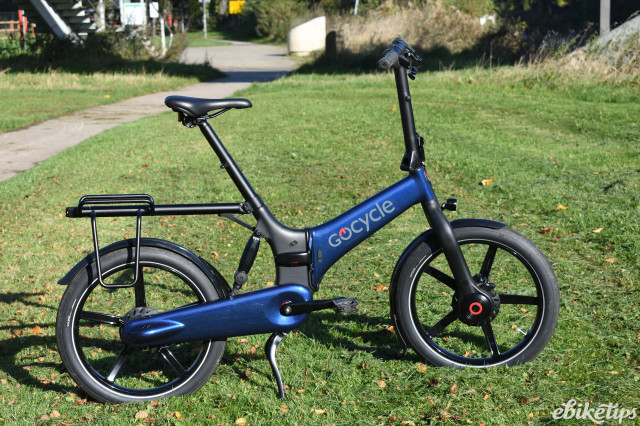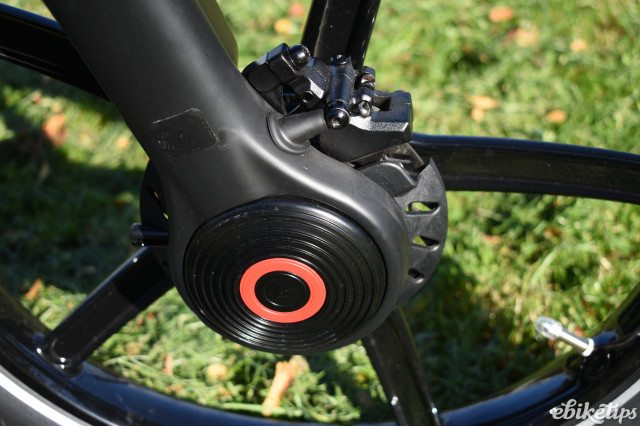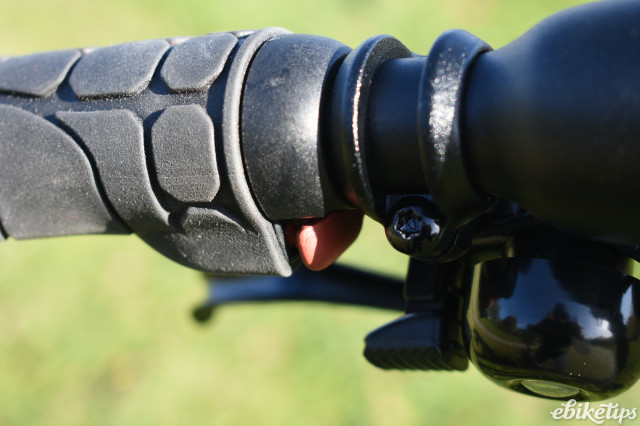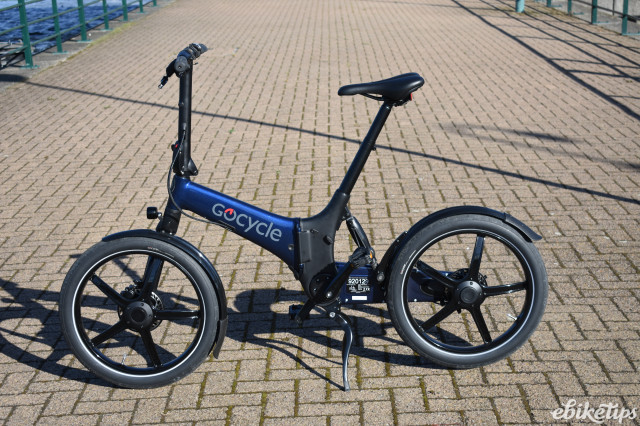Gocycle G4

Overview
- Solid, comfortable ride with super speedy motor performance
- Quick fold
- New lighter weight meaning fold and carry easier
- Battery gauge poor
- No ability to add a trailer
The Gocycle may look futuristic but in fact its parent company Karbon Kinetics has been around since 2002 - though it was 2009 before the first Gocycles appeared on shopfloors. This lengthy gestation is hardly surprising when you look at the own-design technology packed into the bike which includes Pitstop ‘quick change’ wheels on single sided forks (front and rear), a drivetrain totally enclosed in a magnesium case (so-called Cleandrive) and minimalist but effective rear suspension.
These are some of the features that have made Gocycle so popular over the years and which are retained on the latest G4 model. We reviewed the previous incarnation of the folding version of the Gocycle, the GX, back in 2019 when it won the folding bike of the year award, but the latest G4 claims the following improvements and upgrades:
- All-New G4drive front hub motor, quieter and with more torque than its predecessor
- New weight-saving carbon fibre mid-frame joining the hydroformed aluminium front frame and the magnesium Cleandrive casing
- New weight-saving carbon fibre single-sided front fork
- New Gocycle tyre, a MotoGP-inspired treaded tyre infused with silica compound for ‘superior grip and sure-footed handling’
- Integrated USB Port – 1 amp USB charger for phone charging on the go
- Low energy Bluetooth with improved connectivity
- Fast-charging – new Gocycle charger enables fast charging across the range – 3 hours (G4) / 3.5 hours (G4i)
On the road
The Gocycle has to be one of most fun e-bikes I’ve ever ridden - and I’ve ridden quite a few. You get that sports car urge to go quickly because it feels fast as soon as you step on the pedals.
The new, beefier motor just eats up the hills and the new extra plush and extra grippy design of tyre gives you plenty of confidence to corner fast. The exotic frame design of aluminium hydroformed front section, carbon mid-frame and magnesium Cleandrive casing (and magnesium mag style wheels) proved wonderfully stiff and able to transfer pedal power quickly to the road.
Long handlebar posts and the presence of hinges can introduce some flex into some folders, but not the Gocycle. Bars and hinges felt very solid and able to withstand plenty of sporty riding.
Despite the sporty stiffness the latest iteration of the Gocycle remains one of the comfiest e-folders I’ve ridden. The large volume 20” x 2.25” tyres help roll over portholes and drop off kerbs whilst the 25mm proprietary rear suspension and comfy saddle also help make for a ride that feels as plush as it is fast.
Testing the 2019 GX version I was actually unable to generate enough acceleration from the motor to test the traction control, but the revamped, slightly larger G4 motor often needed automatically throttling back on steeper climbs at max power and the traction control worked very impressively. At the first hint of wheelspin the power was toned down, but not too much so as to noticeably lose any speed.
The traction control was most in evidence when using the Boost button, another highly practical and hugely enjoyable feature. It’s a small red button on the inside of the left hand grip and pressing it gives full motor power instantly, with dramatic effect, as the Gocycle sailed up any hill put in front of it, including our short but steep 10% plus grade bike path hill where it compared favourably to the times posted by powerful crank motor e-bikes.
The Boost button is also great for accelerating clear of motor traffic, for example when taking off from traffic lights and when allied with the very sharp steering geometry it makes for a wonderful commuting and city bike, which was the Gocycle’s original brief.
Three hub gears and a fully enclosed drivetrain plus sharp hydraulic disc brakes also add to the easy, practical, intuitive ride and the bike’s very low maintenance credentials.
If you choose the optional front and rear hardwired LED lights, as fitted to my test bike, you should find they make you highly visible and the front light illuminates unlit roads easily without any undue ‘light spray’ to blind oncoming traffic – just what you’d expect from the premium Supernova brand Gocycle have gone with.
Range appears comparable to the G4’s predecessor the GX – I managed around 24 miles over my usual testing ground of pretty hilly Pennine foothill country. It’s perhaps a shade less than I managed with the GX but that’s to be expected given the even zippier motor.
App control
As someone who didn’t grow up with smartphones I do like good old fashioned hardwired buttons, but if you want to use the Gocycle to its full extent you really need the app and a smartphone mounted in the rubber mounting straps on the handlebars. The G4 will work without smartphone input but you won’t be able to change between riding modes, as that is all done over a smartphone Bluetooth connection.
If you are happy with that approach then the app works very well and is pretty intuitive to use, though a hardwired button that lets you toggle between different power modes would surely be a welcome addition for some older riders like me.
I really liked the Mode Editor screen which allows you to set your own custom profiles dictating just how hard you have to pedal to get a given amount of motor response – you get pedal effort in watts across the bottom of a graph and percentage of motor effort on the vertical with two sliders that allow you to dictate how hard you have to pedal to start the motor and to get max power. I went for a fairly shallow line connecting the two to give a nice even application of power whilst keeping up the necessity for a reasonable amount of pedal power and thus a modest workout.
If you want to keep it simple there are three preset modes – Eco, City and On Demand. Eco requires a good amount of pedal input, City gives much more motor assistance for less pedal input, while On Demand lets you use the Boost button only (i.e. you will pedal without assistance until you want it, activated by pressing the Boost button - though you have to keep the pedals spinning to keep the full power of Boost coming).
Once your power modes are set to your satisfaction, you mount the phone on the bars and press the horizontal display icon to get the ‘live’ dash display up. This features a central speedometer and a ‘powermeter’ to the left of it showing the amount of pedal input versus motor input in real time – most helpful in letting you judge how power hungry or efficient any custom riding modes you set are.
You also get average speed, trip distance and odometer stats on the left (though there is a dedicated stats page you can also access with a myriad of other stats if you feel you really want them). You can also toggle through your different power modes on this screen by just tapping the 'select mode' icon.
For me the big weakness was the battery display; this declined in 10% increments and also appeared to fluctuate up and down according to how hard you are working the motor – so for example it may show 50% on the flat but drop down to 40% on a steep hill, or even 30% on an extended very steep hill, before bouncing back up to 50% when back on the flat. This is clearly not very helpful for gauging how much much battery you have really used. By contrast, the likes of Bosch motor systems simply show a 100% figure when full that declines steadily 1% at a time, which is surely the ideal. The red bars on the handlebar also show battery life but I found they also suffered from a similar ‘battery bounce’ problem.
Folding, luggage carrying and carry bags
The Gocycle fold is quick and easy. Just make sure you have the kickstand down and break the bike in two by pressing the red button to undo the main frame hinge.
Then fold the bike in half, drop the handlepost in similar fashion and secure the package together with the small rubber strap. The seatpost removes to be slotted in the middle of the folded package and secured within the rubber strap. With practice it’s a 30-second job.
The G4 is lighter than the old GX and I weighed my test bike at 18.24kg versus the GX’s 18.78kg - though my test bike had a front light which the previous test GX lacked, so a like-for-like comparison probably shows a weight reduction of nearer three quarters of a kilo. If you remove the 1.92kg battery you get a folded bike package of just over 16kg which will bring it into manageable train commuter territory for some, though the likes of Flit and Hummingbird are still out in front in the electric folding weight stakes.
Without the rear rack, it folds to around 83 x 39 x 75cm (with kickstand down – which I found the most useful configuration) – not in the Brompton or Hummingbird league but still OK for train travel if there is plenty of luggage space aboard. The upside of the bigger wheels that result in a bigger folded package is the superior ride quality over more uneven surfaces compared to the Brompton – especially with those lovely Gocycle wide slicks on board.
The Gocycle wasn’t primarily designed as a touring or load carrying bike, hence the relatively small batteries on offer; it’s more about being one of the best performing and best riding city e-bikes out there and it still succeeds admirably on those counts.
However there are useful, if pricey, Gocycle bespoke luggage carrying options in the form of a front bag (£149.99) which has a very handy 24litre / 8kg carrying capacity. You would probably choose this first over the rear pannier rack option, even though it is rated at 10kg, simply because it bolts onto both the frame and seatpost collar. This means you can’t remove the seatpost which therefore stays in situ even when the rest of the bike is folded. I tried it on the test bike and found it easy to fit and very solid feeling in use, even with the max 10kg load on. It also has an integrated rear light.
There are two transit-carrying options – a slip-over style cover at £29.99 that could be useful for regular train travel then taken with you on the bike, and a very substantial travel case (£229) that looks great for protection and wheeling the folded bike short distances but that can’t really be taken with you on the bike.
G4, G4i or G4i+?
Gocycle now offer their folding model in three variants: the G4, as tested here; the G4i that features a bigger battery (375Wh vs 313Wh), height adjustable handlebars and daytime running lightsm plus the option to select ‘predictive’ electronic auto-changing gears; and the G4i+ which is lighter than its less expensive cousins (Gocycle say it weighs 16.9kg), due to the use of carbon wheels.
Prices are £3,399, £3,999 and £4,999 respectively. Whilst I’d seriously consider the step up from G4 to G4i (mainly for the extra battery capacity and range as the motor does munch its way through battery power - especially if you are heavy on the Boost button), the difference, in practical terms, between a sub-18kg bike and sub-17kg bike wouldn’t tempt me to go for the G4i+ (even if I could afford it).
Unfortunately, price hikes seem an increasingly common fact of life in the e-bike world, often to do with reasons beyond the control of the manufacturers, but the fact remains that at £3,399 the G4 is exactly £500 more than the GX model we reviewed in 2019; an average annual price increase of over 8.5% - far in excess of inflation. The comparison is a bit unfair as the G4 is a new, lighter and in many ways a better performing bike.
The demountable G3+, with monocoque magnesium frame and carbon wheels, is still available at £3,999, though probably won’t be for that much longer; Gocycle believe that their e-folders are now able to compete on weight with the demountables, so there’s really no reason to pick a demountable over a folder any more.
Despite the challenging economic backdrop to such price hikes, the Gocycle G4 maintains the company’s innovative tradition and is still one of the best folding city electric bikes out there.
2 comments
I'm curious as to whether the single sided fork and rear triangle can save weight, or indeed even if that was the design purpose.
Presumably the same degree of strength is required as a minimum, probably more to contain the asymmetric loading, so I don't see how any weight can be saved in the amount of structural material.
However the design does lead to a more compact fold, which I presume was the main reason for the design.
"single sided forks"
Is it still a fork if it has only one tine? ![]()





















